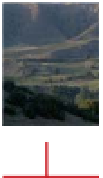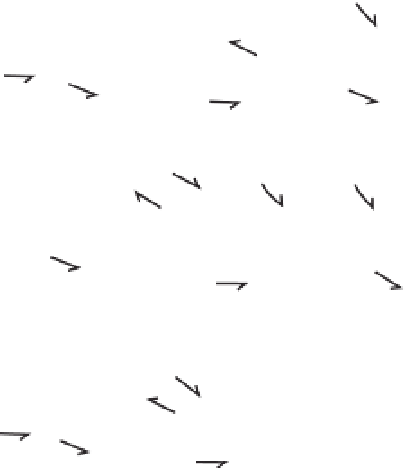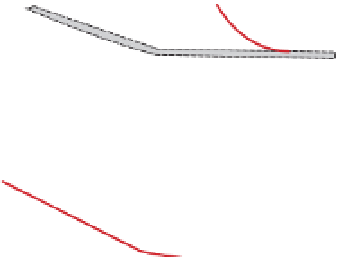Geology Reference
In-Depth Information
belt are affected by high-grade meta-
morphism ranging from eclogite and
granulite facies to upper amphibolite
facies. However, the structurally upper-
most units, seen in the south-west, are
displaced (exotic) terranes containing
mid-Proterozoic rocks that lack penetra-
tive Grenvillian deformation and meta-
morphism and constitute what has been
called the 'lid' of the orogen. The inte-
rior part of the belt contains a number
of large syn- to post-tectonic plutons.
A
~1090-1050Ma
Figure 12.8
Tectonic evolution
of the Grenville orogenic belt.
Simplified sketch sections
illustrating the tectonic
evolution in three stages. 1,
~1090-1050 Ma: tectonic
over-thickening of the crust
causes the warmed lower
mobile crust to extrude along
the Allochthon Boundary
thrust (ABT); this mobile
sheet is bounded by two
shear zones with opposed
senses of movement. 2,
~1020 Ma: a pause in
tectonic compression allows
the orogen to partially
collapse and cool. 3,
~1000-980 Ma: renewed
compression causes activity
to migrate towards the
foreland, causing the warm
lower crustal layer to move
up along the Grenville Front
thrust (GFT). Based on Rivers
(2009).
orogenic lid
ABT
exotic terrane
12
mid
dle cru
st
foreland
lower crust
106
107
shear zones
channel
flow
B
~1020Ma
future GFT
C
~1000-980Ma
Tectonic evolution of the orogen
Two distinct phases of orogenic activity
have been recognised. An earlier phase,
known as the
Ottawan
, dated at 1090-
1020Ma, was responsible for the high-
grade metamorphism of the allochthon
and the thrust-sense movements on the
ABT; a later phase, the
Rigolet
, dated
at 1090-980 Ma, was responsible for
the thrusting at the Grenville Front,
and the related metamorphism and
deformation in the outer autochtho-
nous zone. The evolution of the orogen
has been interpreted in terms of three
main phases of activity (Figure 12.8).
GFT
autochthon
crust
allochthon
crust
exotic
terrane
warm
mobile layer
3. Renewed contraction spreads
outwards into the foreland causing
the uplift of the basement along
the Grenville Front thrust (GFT)
at around 1000-980 Ma.
The Trans-Hudson orogen: the
making of Laurentia
The Early Proterozoic (
Palaeo-prote-
rozoic
)
Trans-Hudson orogenic belt
,
as the name suggests, is centred on
Hudson Bay and resulted from the amal-
gamation of a number of older cratons
and terranes of Archaean age during the
period ~1920 Ma to ~1800 Ma; a process
involving a series of separate collisions
ending with the final collisional event
that brought the Trans-Hudson orogeny
to a close. The end result was the forma-
tion of the Precambrian core of North
America (Figure 12.9) which extends
from Wyoming in the northern USA
to Baffin Island in northern Canada, a
distance of about 3500 km. In the west it
is obscured by younger platform cover,
but the exposed width from there to
1. An early contractional phase
between 1090 and 1020 Ma result-
ing in crustal thickening to around
double its original thickness, result-
ing in the lateral extrusion of a hot
middle-crustal sheet along the Alloch-
thon Boundary thrust (ABT) (i.e.
see
the channel flow process described
in Chapter 10 (
see
Figure 10.4).
The Grenville orogen forms an
interesting contrast with both the
Alpine and the Caledonian orogens
described above, in that it was com-
paratively long-lived (nearly 100 Ma)
and produced high temperature
conditions over a wide area. Because
erosion has revealed deeper crustal
levels than is the case in these younger
belts, it is easier to investigate the
deep structure and to reconstruct
the tectonic processes involved.
2. Gravitational collapse at around
1020 Ma, resulting in the exten-
sional movements on the ABT and
the consequential cooling of the
metamorphic core of the orogen.
















































Search WWH ::

Custom Search